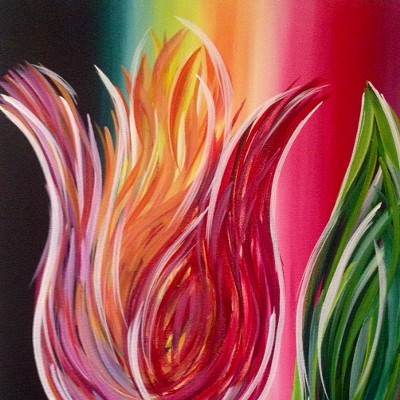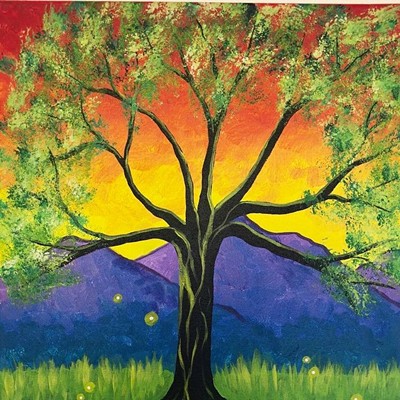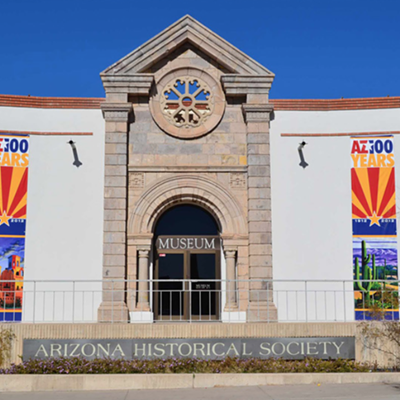Bruce McGrew: A Retrospective provides the first comprehensive look at the work of one of Tucson's best-known and best-loved artists.
The retrospective was first planned while McGrew was alive, but it was delayed because of his death in 1999. Organizing the exhibition was a massive task, most of which fell to McGrew's wife, Joy "Fox" McGrew, and his daughter, Shelley McGrew, who cataloged the works in Bruce's studio. Candice Davis and Mike Dominguez, owners of Davis Dominguez Gallery, which represents McGrew's estate, helped track down the artworks McGrew had sold locally. Edward Putzar photographed everything except the pieces from the museum's collection. Ultimately, Briggs selected about 100 works for the exhibition from over 800 slides.
The retrospective spans 35 years of McGrew's artwork, and it reveals his evolution as an artist, beginning with a 1964 painting created when he was 27 and ending with a painting created in the year of his death. Even viewers familiar with McGrew's artwork may be surprised to see that from the mid-1960s to the mid-1970s he painted realistic and expressionistic portraits in oil on canvas, but Briggs' concept for the exhibition was to show the breadth of McGrew's work.
"I wanted to stress fairly the figurative dimension of his work because I think with the great following that he has for his landscapes, especially of the Southwest and Mexico," he said. "Those always seem to get more play than the figurative . . . . I also wanted to make sure there was a good representation of his mythology--classical from the Mediterranean, Mexican and his own mythology."
McGrew's landscapes are certainly represented, both his realistic watercolors and his more abstract, expressionistic works. Although he created the bulk of his realistic watercolor landscapes early in his career, four display cases of sketchbooks and photographs of the artist show McGrew never stopped going into the field, sketchbook, brush and watercolors in hand. Some of the small watercolors became finished works while others became studies for studio work. In an interview with me in 1998, McGrew talked about being able to return to the same bend in a wash on the Rancho Linda Vista cooperative where he lived for 30 years and never tire of painting it: "This particular part of the world is full of light and space and color [that is] perfectly compatible with my painting."
Light, space and color are the magic in McGrew's expressionistic landscapes. "Tennessee River Light," a large 1993 watercolor, moves upward from the expected to the unexpected. In the foreground, rivulets of blue make their way around gray boulders, but the land beyond the river has turned into waves of color: lemon yellow, blood red, sky blue and more. The sky above is a spreading blur of green as if now invisible trees had exploded into sage and chartreuse light.
Several paintings reveal the ways McGrew used mythology in his artwork. Works like "Rape of Europa (After Titian)" reflect the interest in classical mythology that he developed when he spent a year in Europe on sabbatical in 1971-72. This 1990 mixed-media and collage piece recreates the classical myth of the Greek god Zeus in the form of a white bull carrying Europa (nude) on his back through the sea to Crete, a scene depicted by the Venetian artist Titian.
McGrew also spent many years studying and teaching in Mexico. "Adam and Eve," a 1985 oil-on-canvas painting, transforms Mexican folk figures into a vision of Christianity's icons. Moving from other cultures' mythologies, McGrew developed his own mythology. The three paintings in his 1985 "Trilogy" ("Bird Spirit," "Caribou Bending to Lick Salt" and "River Spirit") reveal how his love of nature evolved into animism with ephemeral figures rising from abstracted backgrounds.
Not only did McGrew adopt the Southwestern landscape when he moved to Tucson in 1962, but he adopted the Tucson community. He was born in Wichita, Kan. and moved to Tucson to attend the UA's MFA program in art. After a two-year teaching stint at the University of Minnesota, in 1966 he returned to Tucson and joined the UA's art faculty where he taught for 33 years. In 1968, the McGrews were one of 10 families and couples who established Rancho Linda Vista, the artists' cooperative in Oracle. McGrew also was one of the early members of the Dinnerware Artists' Cooperative Gallery (now Dinnerware Contemporary Arts Gallery). After over 30 years, the number of artists who knew McGrew was legion.
When the Davis Dominguez Gallery held a memorial exhibition in 2000 to help raise money for a catalog for the UAMA retrospective, it was deluged with McGrew's former students at the opening reception. Some were his former graduate students, and others had simply done one watercolor painting session on a little outing in the Catalina Mountains, but they all had stories to tell about McGrew. Dominguez said, "They would all come and say about the same thing: 'He said something that made a profound difference to me. He gave that one word of encouragement that's part of me now.'"










